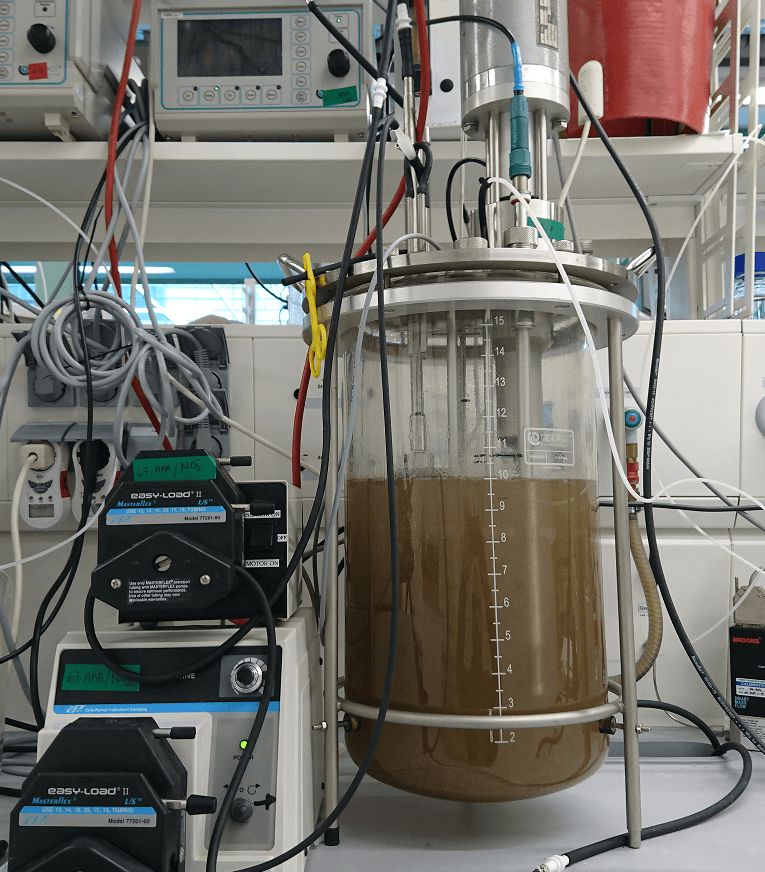Oct 25 2016
A microbe that ‘eats’ both methane and iron: microbiologists have long suspected its existence, but were not able to find it - until now. Researchers at Radboud University and the Max Planck Institute for Marine Microbiology in Bremen discovered a microorganism that couples the reduction of iron to methane oxidation, and could thus be relevant in controlling greenhouse gas emissions worldwide. Their results are published in the scientific journal PNAS on October 24, 2016.
 Tank filled with the discovered iron-munching microbe (copyright Boran Kartal)
Tank filled with the discovered iron-munching microbe (copyright Boran Kartal)
The balance between methane-producing and -consuming processes has a major effect on the worldwide emission of this strong greenhouse gas into our atmosphere. The team of microbiologists and biogeochemists now discovered an archaeon - the other branch of ancient prokaryotes besides bacteria – of the order Methanosarcinales that uses iron to convert methane into carbon dioxide. During that process, reduced iron become available to other bacteria. Consequently, the microorganism initiates an energy cascade influencing the iron and methane cycle and thus methane emissions, describe first authors Katharina Ettwig and Baoli Zhu in the paper.
Application in wastewater treatment
Methanosarcinalesesides, these archaea have another trick up their sleeve. They can turn nitrate into ammonium: the favourite food of the famous anammox bacteria that turn ammonium into nitrogen gas without using oxygen. “This is relevant for wastewater treatment”, says Boran Kartal, a microbiologist who recently moved from Radboud University to the Max Planck Institute in Bremen. “A bioreactor containing anaerobic methane and ammonium oxidizing microorganisms can be used to simultaneously convert ammonium, methane and oxidized nitrogen in wastewater into harmless nitrogen gas and carbon dioxide, which has much lower global warming potential.” The same process could also be important in paddy fields, for example, which account for around 20 percent of human-related emissions of methane.
Closer than expected
While there have been numerous indications that such iron-dependent methane oxidizers existed, researchers have never been able to isolate them. Surprisingly, they were right in front of our doorstep: “After years of searching, we found them in our own sample collection”, says microbiologist Mike Jetten of Radboud University with a smile. “We eventually discovered them in enrichment cultures from the Twentekanaal in The Netherlands that we’ve had in our lab for years. We obtained a large amount of biomass by feeding them with methane and nitrate.” Kartal adds, “Based on the genetic blueprint of these microorganisms, we hypothesized that they could also convert particulate iron coupled to methane oxidation. When we tested our hypothesis in the lab, these organisms did the trick.” In the next step, Kartal wants to look closer into the details of the process. “These findings fill one of the remaining gaps in our understanding of anaerobic methane oxidation. Now we want to further investigate which protein complexes are involved in the process.”
Magical square of microbiology
Years ago, Jetten and his team drew up a table chart with available electron donors and acceptors, that should allow for the growth of – still unknown – microorganisms. A kind of magical square of microbiology. He expected that each box would fit a bacteria or achaeon, since evolution rarely leaves a niche unoccupied. His team has already discovered eight of the nine ghost microorganisms in the table chart: Methanosarcinales fills up the next-to-last box. “This is a really special finding”, Jetten explains. “We hope to discover the last microorganism soon, but Australian and American researchers are snapping at our heels, so these are exciting times.”
Billions of years ago
The newly discovered process could also lead to new insights into the early history of our planet. Already billions of years ago, Methanosarcinales archaea might have abundantly thrived under the methane-rich atmosphere in the ferruginous (iron holding) Archaean oceans, 4 to 2.5 billion years ago. More information on the metabolism of this organism can therefore shed new light on the long-standing discussion of the role of iron metabolism on early earth.